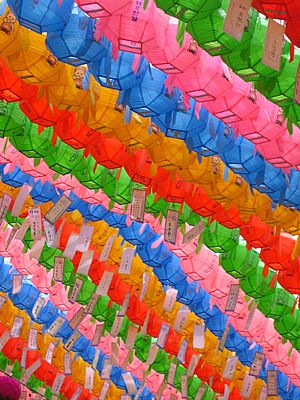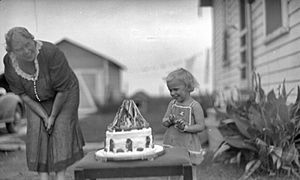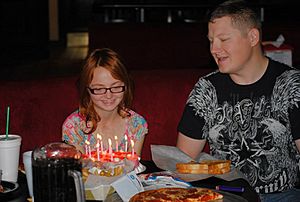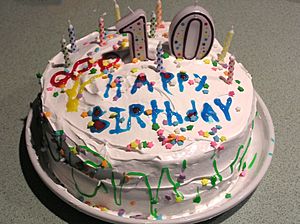Birthday facts for kids
A birthday is an occasion when a person or institution celebrates the anniversary of their birth. Birthdays are celebrated in numerous cultures, often with a gift, party, or rite of passage.
Many religions celebrate the birth of their founders with special holidays (e.g. Christmas, Buddha's Birthday).
There is a distinction between birthday and birthdate: The former, other than February 29, occurs each year (e.g. January 15), while the latter is the exact date a person was born (e.g., January 15, 2001).
Contents
Legal conventions
In most legal systems, one becomes designated as an adult on a particular birthday (usually between 12 and 21). Most countries set the age of majority between 18 and 21.
Cultural conventions
Many cultures have one or more coming of age birthdays:
- In Canada and the United States, families often mark a girl's 16th birthday with a "sweet sixteen" celebration - often represented in popular culture.
- In some Hispanic countries, as well as in Portuguese-speaking Brazil, the quinceañera (Spanish) or festa de quinze anos (Portuguese) celebration traditionally marks a girl's 15th birthday.
- In Nepal and India, on a child's first birthday, their head is shaved while being held by a special fire. Removal of the hair is believed to cleanse the child of any evil in past lives, and symbolizes a renewal of the soul. Hindu male children of some castes, like Brahmins, have the 12th or 13th birthday replaced with a grand "thread ceremony". The child takes a blessed thread and wears it, symbolizing his coming of age. This is called the Upanayana.
- In the Philippines, a coming-of-age party called a debut is held for girls on their 18th birthday, and for boys on their 21st birthday.
- In some Asian countries that follow the zodiac calendar, there is a tradition of celebrating the 60th birthday.
- In Korea, many celebrate a traditional ceremony of Baek-il (Feast for the 100th day) and Doljanchi (child's first birthday).
- In Japan there is a Coming of Age Day, for all of those who have turned 20 years of age.
- In British Commonwealth nations cards from the Royal Family are sent to those celebrating their 100th and 105th birthday and every year thereafter.
- In Ghana, on their birthday, children wake up to a special treat called "oto" which is a patty made from mashed sweet potato and eggs fried in palm oil. Later they have a birthday party where they usually eat stew and rice and a dish known as "kelewele", which is fried plantain chunks.
- Jewish boys have a bar mitzvah on their 13th birthday. Jewish girls have a bat mitzvah on their 12th birthday, or sometimes on their 13th birthday in Reform and Conservative Judaism. This marks the transition where they become obligated in commandments of which they were previously exempted and are counted as part of the community.
The birthdays of historically significant people, such as national heroes or founders, are often commemorated by an official holiday marking the anniversary of their birth.
- Catholic saints are remembered by a liturgical feast on the anniversary of their "birth" into heaven a.k.a. their day of death. The ancient Romans marked the anniversary of a temple dedication or other founding event as a dies natalis, a term still sometimes applied to the anniversary of an institution (such as a university).
A person's golden or grand birthday, also referred to as their "lucky birthday", "champagne birthday", or "star birthday", occurs when they turn the age of their birth day (e.g., when someone born on the 25th of the month turns 25 or when someone born on the ninth turns nine).
An individual's Beddian birthday, named in tribute to firefighter Bobby Beddia, occurs during the year that his or her age matches the last two digits of the year he or she was born.
In many cultures and jurisdictions, if a person's real birthday is not known (for example, if he or she is an orphan), then their birthday may be considered to be January 1. That tradition is followed with horses, their age becoming one, on the first day of the year following their birth and being counted annually after that.
Traditions
In many parts of the world an individual's birthday is celebrated by a party where a specially made cake, usually decorated with lettering and the person's age, is presented. The cake is traditionally studded with the same number of lit candles as the age of the individual, or a number candle representing their age. The celebrated individual will usually make a silent wish and attempt to blow out the candles in one breath; if successful, a tradition holds that the wish will be granted. In many cultures, the wish must be kept secret or it won't "come true". Presents are bestowed on the individual by the guests appropriate to her/his age. Other birthday activities may include entertainment (sometimes by a hired professional, i.e. a clown, magician, or musician), and a special toast or speech by the birthday celebrant. The last stanza of Patty Hill's and Mildred Hill's famous song, "Good Morning to You" (unofficially titled "Happy Birthday to You") is typically sung by the guests at some point in the proceedings. In some countries a piñata takes the place of a cake.
Official birthdays

Some notables, particularly monarchs, have an official birthday on a fixed day of the year, which may not necessarily match the day of their birth, but on which celebrations are held. Examples are:
- Jesus Christ's traditional birthday is celebrated as Christmas Eve or Christmas Day around the world, on December 24 or 25, respectively. As some Eastern churches use the Julian calendar, December 25 will fall on January 7 in the Gregorian calendar. These dates are traditional and have no connection with the actual birthday date of Jesus, which was an unknown date, likely around September or possibly early October.
- Similarly, the birthdays of the Virgin Mary and John the Baptist are liturgically celebrated on September 8 and June 24, especially in the Roman Catholic and Eastern Orthodox traditions (although for those Eastern Orthodox churches using the Julian calendar the corresponding Gregorian dates are September 21 and July 7 respectively). As with Christmas, the dates of these celebrations are traditional and probably have no connection with the actual birthdays of these individuals (and if Jesus was born in September or October, it would seem likely that John the Baptist, who was traditionally regarded to be six months older, was born around March or April).
- The Queen's Official Birthday in Australia, Fiji, Canada, New Zealand, and the United Kingdom.
- The Grand Duke's Official Birthday in Luxembourg is typically celebrated on June 23. This is different from the monarch's actual date of birth, which is on April 16.
- Koninginnedag in the Kingdom of the Netherlands was typically celebrated on April 30. Queen Beatrix fixed it at the birthday of her mother, the previous queen, to avoid the winter weather associated with her own birthday in January. The present monarch's birthday is 27 April, and is also celebrated on that day and has replaced the 30th of April celebration of Koninginnedag.
- The current Japanese Emperor Akihito's official birthday is December 23, which is a national holiday in Japan, whereas his actual date of birth is on November 12.
- The previous Japanese Emperor Showa (Hirohito)'s birthday was April 29. After his death, the holiday was kept as "Showa no Hi", or "Showa Day". This holiday falls close to Golden Week, the week in late April and early May.
- Kim Il-sung and Kim Jong-Il's birthdays are celebrated in North Korea as a national holiday.
- Washington's Birthday, commonly referred to as Presidents' Day, is a federal holiday in the United States that celebrates the birthday of George Washington. President Washington's birthday is observed on the third Monday of February each year. However, his actual birth date was either February 11 (Old Style), or February 22 (New Style).
- In India, every year October 2 which marks the Birthday of Mahatma Gandhi, is declared as a holiday. All the liquor shops are closed across the country in honour of Gandhi not consuming liquor.
- Martin Luther King, Jr. Day is a federal holiday in the United States marking the birthday of Martin Luther King, Jr. It is observed on the third Monday of January each year, which is around the time of King's birthday, January 15.
- Mawlid is the official birthday of Muhammad and is celebrated on the 12th or 17th day of Rabi' al-awwal by adherents of Sunni and Shia Islam respectively. These are the two most commonly accepted dates of birth of Muhammad.
Frequency
According to a public database of births, birthdays in the United States are quite evenly distributed for the most part, but there tend to be more births in September and October.
Based on Harvard University research of birth records in the United States between 1973 and 1999, September 16 is the most common birthday in the United States and December 25 the least common birthday (other than February 29, because of leap years). In 2011, October 5 and 6 were reported as the most frequently occurring birthdays.
In New Zealand, the ten most common birthdays all fall within a thirteen-day period, between September 19 and October 1. The ten least common birthdays (other than February 29) are December 24–27, January 1–2, February 6, March 22, April 1 and April 25.
Time zones and birthminutes
A person's birthday and birthminute is usually recorded according to the time zone of the place of birth. Therefore, for example, if one is born on October 20 at 13:13 UTC+11 in Sydney, Australia, this would be recorded as October 19 at 19:13 UTC−7 in Los Angeles. Such a person, if spending his or her birthday in Los Angeles, would celebrate on October 19. Due to the irregularity of the International Date Line, no person would celebrate his or her birthday on the same day everywhere in the world, and a person born between 10:00 and 11:59 UTC would have three possible birthdays at various positions on the globe. (since the earliest time zone used in the world is UTC-12 and the latest is UTC+14).
Leap day
In the Gregorian calendar (a common solar calendar), February in a leap year has 29 days instead of the usual 28, so the year lasts 366 days instead of the usual 365.
A person born on February 29 may be called a "leapling" or a "leaper". In common years they usually celebrate their birthdays on February 28. In some situations, March 1 is used as the birthday in a non-leap year since it is the day following February 28.
Technically, a leapling will have fewer birthday anniversaries than their age in years. This phenomenon is exploited when a person claims to be only a quarter of their actual age, by counting their leap-year birthday anniversaries only. In Gilbert and Sullivan's 1879 comic opera The Pirates of Penzance, Frederic the pirate apprentice discovers that he is bound to serve the pirates until his 21st birthday rather than until his 21st year.
For legal purposes, legal birthdays depend on how local laws count time intervals.
Astrology
A person's astrological sign is based on his or her birthday.
Symbolism
Birthstones
A birthstone symbolizes the month of birth. In 1912, the Jewelers of America agreed on a list of birthstones:
| Month | Modern Birthstone | Alternate | Traditional Birthstone |
|---|---|---|---|
| January | Garnet | Rose Quartz | Garnet |
| February | Amethyst | Onyx | Amethyst |
| March | Aquamarine | Red Jasper (Bloodstone) | Bloodstone, Jasper |
| April | Diamond | Rock Crystal (Quartz) | Diamond, Sapphire |
| May | Emerald | Chrysoprase | Emerald, Agate |
| June | Pearl (the only non-mineral), Moonstone | Alexandrite | Alexandrite, Emerald |
| July | Ruby | Jade or Carnelian | Ruby, Onyx |
| August | Peridot | Aventurine, Sardonyx, or Sapphire | Sardonyx, Carnelian |
| September | Sapphire | Lapis lazuli | Sapphire, Peridot |
| October | Opal | Pink Tourmaline | Tourmaline, Aquamarine |
| November | Yellow Topaz | Citrine or Turquoise | Citrine, Topaz |
| December | Turquoise, Blue Topaz | Lapis Lazuli or Tanzanite | Zircon, Ruby |
Images for kids
-
Birthday cakes are very commonplace in birthday celebrations. Here, a black forest cake is adorned with candles and a topper indicating the recipient's 40th birthday.
See also
 In Spanish: Cumpleaños para niños
In Spanish: Cumpleaños para niños













